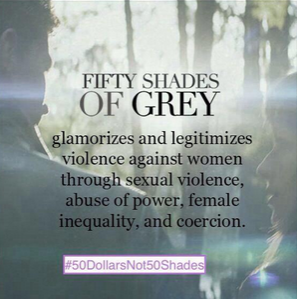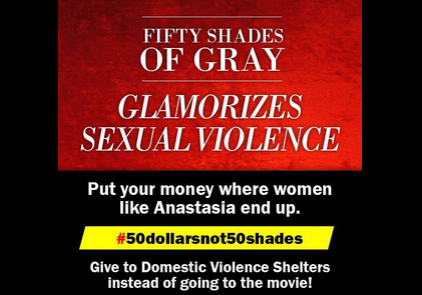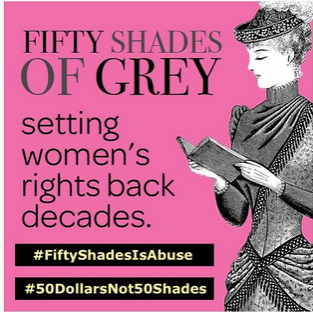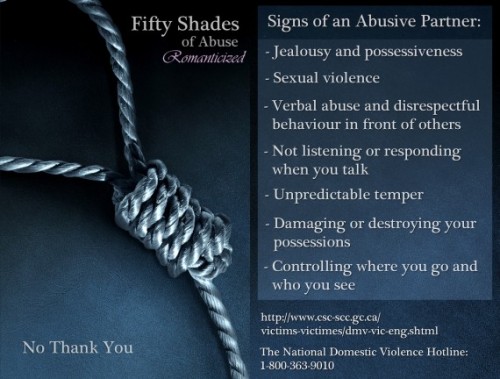 Feb. 12, 2015 “What people do in private is their own business.” But what happens when Hollywood makes a movie glorifying, promoting and normalizing violence against women and coerced sex? It becomes the business of everyone to examine the message our kids are receiving from it.
Feb. 12, 2015 “What people do in private is their own business.” But what happens when Hollywood makes a movie glorifying, promoting and normalizing violence against women and coerced sex? It becomes the business of everyone to examine the message our kids are receiving from it.
Couldn’t have said it better myself.
Those are the words of Educate Empower Kids.org’s Amanda Grossman-Scott sharing her parenting views with us today, amidst the mass marketing blitzkrieg of Fifty Shades of Grey, which activists have tagged #FiftyShadesIsAbuse for its mainstream normalization of violence against women, launching petitions and pleas to redirect fiscal support to women’s shelters serving domestic violence survivors using participatory social media clout via the hashtag #50DollarsNot50Shades.
I’ve written extensively about the damaging fallout when entertainment industry profiteering promotes preventable public health problems by sending mass, mixed messages to youth such as the year the Grammys placed Rihanna and Chris Brown center stage post-beating, unraveling behavioral signals for domestic abuse survivors everywhere and upending the hard work of activists worldwide…or the year the “Man Down” video went viral, about a woman who shoots and kills her rapist in a crowded train station…or the Eminem/Rihanna Love the Way You Lie flaming controversy and backdraft of unhealthy relationships glamorized in vignettes, so it’s no surprise I’m not a fan of the Fifty Shades of Gray sensationalized assault on our senses.
 The normalization of unhealthy relationships by premiering 50 Shades as any form of ‘romance’ on Valentine’s Day is particularly troubling, as it sells a massively twisted tale smack dab amidst Teen Dating Violence Awareness Month, which the CDC shares 1 in 10 teens reporting being hit or physical hurt (1 in 3 including emotional abuse, see teen DV outreach resources).
The normalization of unhealthy relationships by premiering 50 Shades as any form of ‘romance’ on Valentine’s Day is particularly troubling, as it sells a massively twisted tale smack dab amidst Teen Dating Violence Awareness Month, which the CDC shares 1 in 10 teens reporting being hit or physical hurt (1 in 3 including emotional abuse, see teen DV outreach resources).
Toss in the 50 Shades coercion, stalking, and rape culture credo normalized as erotica when in fact NSPCC stats reveal 40% of teenage girls are pressured into having sex and it’s apparent media’s recklessly stoking the flames of an escalating public health problem, far beyond college campus sexual assaults making headline news.
 Make no mistake, this is not a ‘pearl clutching prude’ hand-wringing moment for those purporting a ‘to each their own’ sexuality message, this is damaging positioning of violence against women as erotica, requiring a parenting primer on WHY we need to talk to teens (and even younger kids in an age appropriate manner, as ambient advertising and retail displays cannot be ‘turned off or tuned out’ with mega-millions marketing sex toys adjacent to kids’ toothbrushes at Target).
Make no mistake, this is not a ‘pearl clutching prude’ hand-wringing moment for those purporting a ‘to each their own’ sexuality message, this is damaging positioning of violence against women as erotica, requiring a parenting primer on WHY we need to talk to teens (and even younger kids in an age appropriate manner, as ambient advertising and retail displays cannot be ‘turned off or tuned out’ with mega-millions marketing sex toys adjacent to kids’ toothbrushes at Target).
Related reading and a bounty of resources from our Shaping Youth archives at the end…
Meanwhile, here’s Amanda with a guest post/parenting primer of what all the fuss is about…and don’t miss “50 Health Literacy Talking Points” housed under our media literacy deconstruction section to get that dialogue started!
The Fifty Shades Effect: Disempowerment of Young Girls
And What We Can Do About It
by Amanda Grossman-Scott
In 2013, social scientist Amy Bonomi, Ph.d published a study which assessed the Fifty Shades series for qualities of intimate partner violence. It used the CDC’s standards for emotional abuse and sexual violence. The study concluded: “Fifty Shades—a blockbuster fiction series—depicts pervasive violence against women…” (Bonomi, A., et. al, 2013-emphasis added)
This study connected the dots for us as a society and as parents. And yet… most of the population refuses to see the danger in ignoring the normalization of mixing violence and sex. Of muddying the waters of consent and equality in a relationship. For decades we have endured this and it’s time we questioned… Why?
WHY DOES VIOLENCE AGAINST WOMEN BECOME INVISIBLE ONCE SEX IS ADDED TO THE MIX?
Why do we refuse to see the results of our blindness? Why do we not recognize that “depictions of violence against women in popular culture —such as in film, novels, music, or pornography—create a broader social narrative that normalizes these risks and behaviors in women’s lives.”(Bonomi, A., et. al, 2013-emphasis added)
“Our study showed strong correlations between health risks in women’s lives—including violence victimization—and consumption of Fifty Shades, a fiction series that portrays violence against women.” (Bonomi, A., et. al, 2013-emphasis added)
“Emotional abuse is present in nearly every interaction [between the two main characters in Fifty Shades], including: stalking…; intimidation…; and isolation. … using alcohol to compromise Anastasia’s consent, …Anastasia experiences reactions typical of abused women, including: constant perceived threat…; altered identity (describes herself as a “pale, haunted ghost”); and stressful managing (engages in behaviors to “keep the peace,” such as withholding information about her social whereabouts to avoid Christian’s anger). Anastasia becomes disempowered and entrapped in the relationship as her behaviors become mechanized in response to Christian’s abuse.” (Bonomi, A., et. al, 2013-emphasis added)
I grant that there is a certain percentage of the population who engage in BDSM (bondage, domination or discipline, sadism or submission and masochism) type behavior. That’s their right (as long as it’s consensual).But my right, as a mother and as a sexually healthy human being is not to be made to feel like BDSM is what the average person does.
How am I to teach my sons that it’s not okay to strike someone to get what they want? How will I teach them that tenderness and kindness are true representations of love when Fifty Shades teaches young boys that they can do whatever they want to a girl: so long as they buy her expensive gifts first? How will I teach my daughter that men should treat her with respect and equality when the best selling book of all time tells her that she should obey and acquiesce to keep her “lover” calm and happy? Not to mention the fact that she should be ready to be whipped (among other abuses) to prove her love and dedication to another person?
Because the BDSM in Fifty Shades goes so far beyond sex- and into the realm of domestic violence-it’s particularly damaging to a society that continues to push love and sex further and further apart.
The popularity of this movie is perpetuating the myths that control=love, that coerced consent=actual consent; that violence=love and that, apparently, every young person should understand this.
We as parents can take this opportunity to educate ourselves and our children. Talking to our kids about sex is the best way to begin establishing healthy sexual attitudes. Some things that will help negate the information our children might learn from outside sources are:
- Discuss the characteristics of a healthy relationship like equality, dignity, mutual respect and boundaries.
- Explain consent; that everyone has the right to say “no” and what it means for both parties.
- Talk about the beauty of sex; that it can be a natural physical expression of emotional love.
- Examine the messages your kids receive from the media. How these messages attempt to normalize behaviors that are abnormal and atypical in a healthy relationship.
- Teach your child to think critically and examine their feelings about the media to which they are exposed.
We have a powerful influence on our children’s standards and ideals. We as parents can set the example in our relationships and in the media we bring into our homes. We can say “this isn’t love, this isn’t healthy” to our children. We can take a stand against domestic violence. We can say “we won’t be misled by your distorted version of sex and love” to Hollywood-all with one action: talking to our kids. For additional guidance, look to our recently released book series 30 Days of Sex Talks; Empowering Your Child with Knowledge of Sexual Intimacy.
The more you talk about these topics, the more you will arm your children with the knowledge and confidence they need to combat the negative and damaging messages they are exposed to every day. They will make better decisions in future relationships and feel more self-confident in their understanding of the world around them.
Sources: Amy E. Bonomi, Lauren E. Altenburger, and Nicole L. Walton. Journal of Women’s Health. September 2013, 22(9): 733-744. doi:10.1089/jwh.2013.4344.
About the Author: Amanda Grossman-Scott of “Educate, Empower Kids.org” has written for various magazines, newspapers and blogs and has been active in the journalism industry intermittently for the last 15 years. She studied Journalism and Communications at West Virginia University and Utah Valley University. She lives with her husband, Todd, three children and five goldfish in Sacramento, California.
Visual Credits: Graphics via Twitter #50DollarsNot50Shades, AntiPornography.org respectively
Related Reading by Amy Jussel on Shaping Youth
No More/NFL: Reading Between the Lines A Media Literacy Education in Domestic Violence
Circle of 6 Campus Dating App: What it Is and What it Isn’t
Victim Blaming, “Asking For It” And Baiting Outrage on the Radio
Love is Respect: Teen Texting Tools to Get Dialed In To Dating Abuse
The Bro Code: Media, Masculinity & Misogynistic Misfires
Public Health and the Grammys: Rihanna/Chris Brown DV Messaging
Media Messaging, Binge Drinking and Teens
Depravity Gone Viral: A Thin Line For Humanity
Man Down? Girl Up, Rihanna. Own Your Influence.
What Does A 13-Year Old Boy Know About Dating Violence? Plenty.
Backdraft: DV=Differing Views on Dating/Domestic Violence
Attention KMart Shoppers, Dating Violence on Aisle 3
Predatory Practices As Sport? Boys to Men & Swaggerfests
Gender, Race & Sexism: Shaping Youth Through Pop Culture Cues
Talk to Me: Because Media Matters for Youth Outreach
Uplifting, Positive Picks for Youth Outreach: Resource Roundup
Dear Media, Please Change Your Channel of Influence
Teaching Moments: Get Boys to Participate in “GirlCaught” to Dial Down Disrespect
Girls As Boy Toys Takes an Even More Toxic Turn
Helpful Resources For DV Outreach, Life Literacy
Teen Dating Violence Awareness Month: Research/Facts
10 Things Men Can Do About Gender Violence: Jackson Katz
Love Is Not Abuse (List of Partner Links)
CDC Violence Prevention Homepage
CDC Violence Prevention PDF Download
A Thin Line.org-MTV’s Over the Line (digital abuse/teen control)
National Coalition Against Domestic Violence
See It and Stop It! Organization
LiveStrong: Teen Dating Violence
Love is Not Abuse.com (Liz Claiborne campaign)
APA: Teens/Love Doesn’t Have to Hurt (pdf)
HelpGuide.org: Cycle of abuse/DV; cause-effect
HSUS/Animal abuse & corollary w/domestic violence
Center for Relationship Abuse Awareness










Speak Your Mind